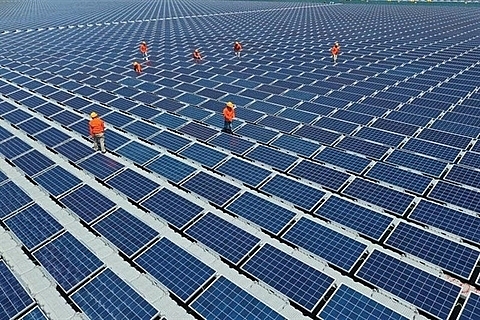Vietnam energy sector a magnet for foreign investors
 |
| A project of rooftop solar power in HCM City. VNA/VNS Photo |
The economy is expected to grow at 6.5-7.5 per cent annually until 2030, and would require 90,000MW of power by 2025 and 130,000MW by 2030.
At the 2020 Vietnam Energy Summit in July in Hanoi a number of deals for investment in energy projects were signed, including the memorandum of understanding by the Copenhagen Infrastructure Partners, Asiapetro and Novasia Energy with the Binh Thuan Province People’s Committee to develop the 3.5GW La Gan offshore wind power project at a cost of US$10 billion.
Many investors said Resolution No 55-NQ/TW for strategic orientations for national energy development through 2030 has created a favourable environment to invest in the country’s power sector.
The resolution prioritises renewable and clean energy, offering foreign investors a great opportunity, experts said.
Hoang Tien Dung, director of the Electricity and Renewable Energy Authority, said: “Existing regulations allow the [sale] of projects to eligible foreign investors. Transferring projects and changing shareholders need approval from the Ministry of Planning and Investment or the Department of Planning and Investment depending on scale."
As of May 11 Vietnam had 92 solar and 10 wind power plants with a total capacity of nearly 6,000 MW in operation, according to the Department of Electricity and Renewable Energy.
A number of them have been sold partially or wholly to foreign investors from Thailand, the Philippines, China, Singapore, and Saudi Arabia.
Coal and gas power projects are invested under the build-operate-transfer model with Government guarantees, but solar and wind power projects do not have such guarantees.
Foreign investors, with their great experience and capability in investing in and managing plants bring investment efficiency and thus greater benefit to society.
The development of renewable energy is helping reduce dependence on costly oil-fired power plants and greenhouse gas emissions.
Feed-in tariffs (FIT) for solar power were considered too high, and though they fell quickly as technology improved from 9.35 US cents per kilowatt-hour in 2017 to 7.09 cents last year for plants on land, they remain quite high compared with other countries.
According to Nguyen Tam Tien, general director of Trung Nam Group, one of the leading wind power producers with 12 projects underway in Vietnam, wind power cannot be cheap in the country yet.
“Since 100 per cent of wind power equipment has to be imported and power producers suffer from a lack of skilled labour, it is difficult to meet the low prices the FIT mechanism suggests.”
According to the latest study by the World Bank, more than 39 per cent of the country’s land area has annual average wind speeds of over 6m/s at a height of 65m, equivalent to a total capacity of 512GW. The offshore potential is 475GW.
What the stars mean:
★ Poor ★ ★ Promising ★★★ Good ★★★★ Very good ★★★★★ Exceptional
Related Contents
Latest News
More News
- Heavy industries set for pilot greenhouse gas quotas (December 25, 2025 | 10:00)
- Swedfund invests in MSME growth and climate action in Vietnam (December 19, 2025 | 11:42)
- GreenYellow brings solar energy to light up remote schools in Tuyen Quang province (December 19, 2025 | 08:00)
- Charge+, Grab partner to develop EV charging network in Vietnam (December 18, 2025 | 17:11)
- Linking sci-tech and innovation to Vietnam’s net-zero future (December 18, 2025 | 14:31)
- Driving double-digit growth through green and circular transformation in Vietnam (December 17, 2025 | 09:00)
- Standard Chartered and ACCA deepen collaboration to develop Vietnam’s talent for a sustainable future (December 15, 2025 | 18:18)
- Schaeffler reports strong early output from Dong Nai solar project (December 12, 2025 | 15:16)
- Forestry conference highlights biodiversity and sustainability goals (December 09, 2025 | 13:35)
- Home Credit honoured among top 10 sustainable companies in trade and services (December 09, 2025 | 12:18)

 Tag:
Tag:





















 Mobile Version
Mobile Version